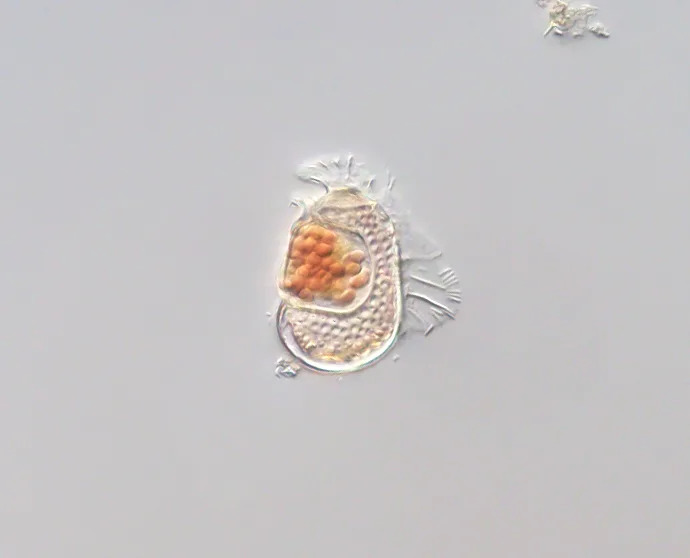It's tiny and needy, but is it alive?
That's a question prompted by recent research that highlights a surprisingly complex part of biology.
The organism in question is a microbe called Sukunaarchaeum mirabile, discovered by researchers in Canada and Japan who were looking at the DNA of a species of marine plankton, according to a new paper published on bioRxiv.
They've found it's unusually reliant on an alive host to survive, which could further blur the lines between cellular life and viruses — which generally considered to not be alive.
TheNational Human Genome Research Institutedescribes viruses as existing "near the boundary between the living and the nonliving."
Viruses can't function without interacting with a living cell. On their own, they're also essentially inert – unable to move – asa 2017 study notes.
Enter Sukunaarchaeum mirabile, which could complicate things further.
What is it?
"This organism represents a totally new branch in the archaeal tree of life," lead researcher Takuro Nakayama of the University of Tsukuba told USA TODAY. (Archaea are microorganisms that define the limits of life on Earth.)
"Sukunaarchaeum is not a virus, but a highly streamlined cellular organism," Nakayama said.
According to the new study, which has yet to be peer-reviewed, "the discovery of Sukunaarchaeum pushes the conventional boundaries of cellular life and highlights the vast unexplored biological novelty within microbial interactions."
 Hidden inside this dinoflagellate (Citharistes regius) is a tiny microbe so reliant on its host that scientists say it’s the most viruslike cellular organism known, according to Science magazine.
Hidden inside this dinoflagellate (Citharistes regius) is a tiny microbe so reliant on its host that scientists say it’s the most viruslike cellular organism known, according to Science magazine.Named for a Japanese deity
Named for a Japanese deity known for its tiny size, Sukunaarchaeum has one of the smallest genomes ever recorded: "Its genome is drastically reduced – less than half the size of the previously smallest known archaeal genome," Nakayama said.
The authors in the study write that "its genome is profoundly stripped-down, lacking virtually all recognizable metabolic pathways, and primarily encoding the machinery for its replicative core: DNA replication, transcription, and translation."
"This suggests an unprecedented level of metabolic dependence on a host, a condition that challenges the functional distinctions between minimal cellular life and viruses,” the study says.
'The tip of the iceberg'
"Sukunaarchaeum could be just the tip of the iceberg, pointing to a hidden diversity of life forms with ultra-reduced genomes within the so-called 'microbial dark matter,'" Nakayama told USA TODAY.
Indeed, the discovery of Sukunaarchaeum’sbizarrely viruslike way of living “challenges the boundaries between cellular life and viruses,” Kate Adamala, a synthetic biologist at the University of Minnesota Twin Cities who was not involved in the work, told Science magazine. “This organism might be a fascinating living fossil – an evolutionary waypoint that managed to hang on.”
The study concludes that "further exploration of symbiotic systems may reveal even more extraordinary life forms, reshaping our understanding of cellular evolution."
What does 'life' mean to scientists?
"I am not an expert on the philosophical definition of 'life," Nakayama said, adding that the definition is not uniform among scientists and is a subject of continuous debate.
"Many scientists would agree that cellular structure, the ability to replicate, and the ability to metabolize are key features of life. Viruses typically lack these features," he said.
"The discovery of Sukunaarchaeum is interesting in this context because it lacks one of those key features: metabolism. The existence of a cellular organism that seemingly lacks its own metabolism provides a new and important perspective to the ongoing discussion about the definition and minimal requirements of life."
Contributing: Joel Shannon, USA TODAY
This article originally appeared on USA TODAY: A mysterious microbe raises questions about life
The narrative of how a microscopic entity like bacteria ignites profound reflections on life raises intriguing questions about the intricacies and interconnectedness that exist between even minute organisms, challenging us to ponder not just survival but existence itself.
In the tiny world of a single microbe, we find poignant reminders that life on Earth is not merely about our larger-than-life struggles; it also whispers to us through these microscopic wonders how interconnected and profound every living being's existence truly can be.
Life, in its most fundamental form as captured by a single microbe's existence proposes profound questions to our understanding of complexity and interconnectedness: What is life? It all starts small but begets great enigmas.
A single microbe, with its minuscule yet mighty existence among the vast expanse of life on our planet Earth,...begs a fundamental question: what truly makes up this interconnected tapestry we know as 'life'-spanning from cosmic marvels to these unseen microbial wonders?
In the tiny world of a single microbe, lies profound ponderings that echo through life's vast landscapes—a testament to how even our tiniest understanders can breed major philosophical queries on existence and purpose.
Life, a grand mystique illuminated by the intricate wisdom of even minimal microbial existence. A single microbe concocts within its morsel questions about our very essence – a testament to nature's profound capacity for subtle yet majestic inquiries.














